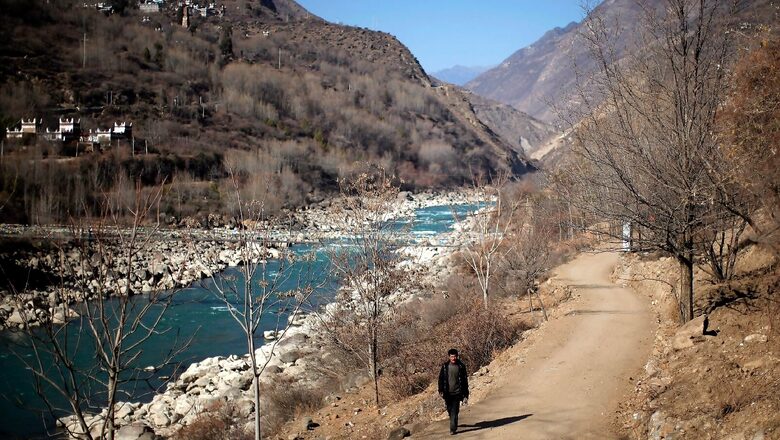
views
When China invaded Tibet in 1949, a largescale exodus of people occurred. Many, however, remained in their homeland – hoping that the Chinese occupation would one day come to an end. Such hopes linger on to this day, with the slight exception of China altering the way Tibet has existed for millennia, perhaps permanently so. Tibet, along with the Himalayas, is known as the “Third Pole” of the world. Glaciers are natural formations found in the North and South Poles alone, which is to say that these structures cannot be found outside the Arctic and Antarctic regions. The only exception, though, is the Tibetan plateau and the Hindukush Himalayan range. Here, glaciers are found in abundance and feed the water needs of close to two billion people.
The glaciers here are now melting away, and that is a cause of grave concern for billions in the Indian subcontinent and in Southeast Asia who depend on the Tibetan plateau to sustain their day-to-day lives. According to the International Centre for Integrated Mountain Development (ICIMOD), at least a third of the glacial region in this part of the world will melt due to the climate crisis if carbon emissions are not cut drastically. Tibet and its adjoining areas are sources of 10 major rivers that deliver water to a quarter of the world’s population.
Tibet is also witnessing a worrying trend of recording average hikes in temperature that are twice the global average. The temperature of Tibet rose by 0.44 degrees Celsius per decade from 1979 to 2020. Calling Tibet the ‘Water Tower’ of South Asia alone would be an understatement. As a matter of fact, the region also feeds water to areas of Afghanistan, Tajikistan and Kyrgyzstan. Within Tibet, a dichotomous scenario has come to exist. The northern region is receiving excessive rainfall due to the heightened activity of the westerlies, while the southern region is grappling with droughts and high temperatures.
Meanwhile, the melting of glaciers not only threatens to initially flood low-lying regions and subsequently lead to the rise of aridity, but also cause major health problems among billions of people. A team of researchers at the Chinese Academy of Sciences has found close to 1,000 species of bacteria in snow and ice samples collected from Tibetan glaciers. Their paper, published in the journal Nature Biotechnology claims that the melting of glaciers would unleash these species of bacteria into nature, potentially leading to hazardous health crises. 98 per cent of the bacteria discovered from the melting glaciers have never been seen before.
China’s Culpability
China has played a pivotal role in destroying the Tibetan ecosystem. From building unsustainable hydropower projects across Tibet to setting up the required infrastructure to construct such dams, Beijing has acted with absolute impunity against Tibet’s environment. It is not without cause that the temperature hikes over Tibet are twice the global average. China has been exploiting Tibet to fuel its own sloppy growth engine, especially as the country continues to face incessant bouts of Covid-19, almost three years after the pandemic first broke out.
China has begun large-scale mining of Lithium and Uranium in Tibet, impacting not just the region’s overall carbon footprint, but also altering the Monsoon cycle. According to Tibet Press, a CCP-sponsored White Paper titled ‘Tibet since 1951: Liberation, Development and Prosperity from Beijing’ shows how Beijing has scant regard for the environment of Tibet. In fact, China is now being accused of using Tibet as a “dumping ground”.
Beijing is pushing infrastructure development in Tibet at an unprecedented scale – mostly to challenge India and reinforce its occupation over the region. Dams, you see, are not singular structures. Chinese dams are big, and to construct them, a lot of associated infrastructure – roads, bridges among other structures need to be built first. All of this has a cumulative negative impact on the area’s ecosystem. Meanwhile, unregulated mining in Tibet is leading to a release of earth-warming hydrocarbons in a big way, which plays a direct role in glacial melting and the thawing of permafrost – which is a permanently frozen layer on or under the Earth’s surface.
Meanwhile, the mining coupled with all of China’s “developmental works” in Tibet is causing the water quality in the region to deteriorate. Since Tibet is a source that feeds several rivers and streams, the contamination of water is bound to lead to catastrophic outcomes for not just Tibetans, but Asians at large.
China knows it is guilty of mass destruction. That is precisely why the Communist nation is hunting down environmental activists who dare to speak against the Chinese state’s excesses on Tibet’s environment. There are at least 50 ‘known’ cases of China persecuting Tibetan environmental activists since 2008.
In 2021, under its latest Five-Year Plan, China allocated USD 30 billion to ramp up infrastructure in Tibet. The money will be used for building new expressways, upgrading existing highways and improving the road conditions in rural areas, among other fields.
Also Read: Water Imperialism and Future Water Wars – Why China Has Colonised Tibet
Freshwater resources in North China are scarce and polluted. Therefore, China has, of late, come to depend on the water sources of Southern China, and Tibet in particular. To quench the thirst of water-deprived North, China is overseeing the construction of the world’s most expensive water project, called the ‘South-to-North Water Diversion Project’. Diversion of water to China’s thirsty regions will definitely alleviate the water woes of the country’s most populated, industrial and economically consequential regions, but the repercussions for Tibet will be devastating, and they have, as of now, only begun showing effect. The worst for Tibet is yet to come.
Tibet is being exploited and contaminated by China. Its serene environment is being polluted by Beijing, and its people are being oppressed. Now, China’s activities in Tibet pose a security threat to all of Asia, especially the likes of India, Pakistan, Nepal, Bangladesh and of course, the Mekong River basin countries, which have already begun facing all-out water wars from Beijing.
Read all the Latest News, Breaking News, watch Top Videos and Live TV here.




















Comments
0 comment